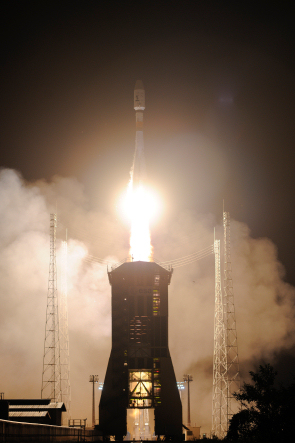Launch Vehicle
Gaia was launched on a Soyuz-STB/Fregat launch vehicle from the European Spaceport in Kourou, French Guiana, on 19 December 2013.
The Soyuz-Fregat rocket was procured from Arianespace through Starsem, a European-Russian company that markets Soyuz launchers outside Russia. Starsem has four shareholders: EADS Space, Arianespace, the Russian Federal Space Agency (ROSCOSMOS) and TsSKB-Progress, based in Samara, Russia.
 |
|
Launch of Gaia on Soyuz VS06. Credit: ESA - S. Corvaja, 2013 |
The Soyuz launch vehicle family has provided reliable and efficient launch services since the birth of the space programme. Vehicles in this family, which launched both the first satellite and first man into space, have made more than 1700 successful launches – making it by far the world's most used and most reliable launch vehicle.
On 8 November 2004, the inaugural flight of the Soyuz 2-1a launch vehicle took place at the Plesetsk Cosmodrome. This modernized version of Soyuz, which was used for the ESA Earth Observation mission MetOp-A, implements a digital control system providing additional mission flexibility and enables control of the launch vehicle with the 4.1 m ST fairing. It represents a necessary milestone towards the next generation evolved Soyuz 2-1b launcher as the latest step in a cooperative European/Russian evolution program.
Soyuz is a four-stage launch vehicle. The vehicle consists of four boosters (first stage), a central core (second stage), a third stage, and the restartable Fregat upper stage (fourth stage). Each vehicle also includes a payload adapter/dispenser and fairing.
First Stage
The four boosters sit around a central core and are tapered cylinders with the oxidizer tank in the tapered portion and the kerosene tank in the cylindrical portion. Liquid oxygen and kerosene, the same propellants that are used on each of the lower three stages, power the booster's RD-107A engines. Each engine has four combustion chambers and nozzles. Three-axis flight control is carried out by aerofins (one per booster) and movable vernier thrusters (two per booster). This stage normally burns for 118 seconds.
Second Stage
The central core is similar in construction to the four boosters, with a hammer-head shape to accommodate the boosters. A stiffening ring is located at the interface between the boosters and the core. This stage has a RD-108A engine with four combustion chambers and nozzles and four vernier thrusters. The verniers are used for three-axis flight control once the boosters have separated. The core stage nominally burns for 286 seconds. Ignition of the central core and boosters occurs at an intermediate level of thrust on the launch pad 20 seconds before launch in order to monitor engine health parameters before the engines are throttled up and the vehicle leaves the pad.
Third Stage
The third stage is linked to the central core by a latticework structure. Ignition of the third stage’s main engine occurs approximately 2 seconds before shutdown of the central core. The third stage engine’s thrust directly separates the stage from the central core. In between the oxidizer and fuel tanks is an intermediate bay where avionics systems are located. This stage uses a RD-0110 engine with four combustion chambers and nozzles. Four vernier nozzles provide three-axis flight control. The third stage engine nominally burns for 240 seconds. After engine cut-off and separation of the fourth stage, the third stage performs an avoidance manoeuvre by opening an outgassing valve in the liquid oxygen tank.
Fregat Stage
Flight qualified in 2000, the Fregat upper stage is an autonomous and flexible upper stage designed to operate as an orbital vehicle. It extends the capability of the lower three stages of the Soyuz vehicle to provide access to a full range of orbits (LEO, SSO, MEO, GTO, GEO and escape).
The upper stage consists of six spherical tanks (4 for propellants, 2 for avionics) arrayed in a circle, with trusses passing through the tanks to provide structural support. The stage is independent from the lower three stages, having its own guidance, navigation, control, tracking, and telemetry systems. The stage uses storable propellants (UDMH/NTO) and can restart up to 20 times in flight, thus enabling it to carry out complex mission profiles.
Digital Control System
The modernized version of Soyuz includes a digital control system for the first three stages, with a digital computer and inertial measurement unit giving the Soyuz improved navigation accuracy and control capability. The digital control system is located primarily in the equipment bay of the third stage. The introduction of the digital control system leads to the following advantages:
- A more flexible and more efficient attitude control system (ACS) capable of handling the increased aerodynamic instability generated by the larger ST fairing.
- Increased accuracy in the flight of the first three stages of the Soyuz.
- The ability to perform in-flight roll manoeuvres as well as in-plane yaw steering (dog-leg) manoeuvres.
Payload Accommodation
The current Soyuz flies the ST-type fairing, with external diameter of 4.1 m and a length of 11.4 m. The Fregat upper stage is encapsulated in the fairing with the payload and a payload adapter/dispenser.
